Brand loyalty is driven by customers’ positive feelings toward a brand, their dedication to purchasing the brand’s products or services repeatedly, and their promotion of the brand, whether online or in-person. Customer experience (CX) focuses on the relationship between a business and its customers.
So, it logically follows that a business which invests in enhancing its CX would by extension increase its brand loyalty. However, building brand loyalty through customer experience requires vision, purpose, and research.
Some organizations are out of sync with their customers or are moving at a pace slower than consumers change. If an organization’s CX fails to meet standards set by companies with which it does not directly compete, then it could be seen as a failure. That’s because customer expectations have become liquid across different product and service categories. People no longer compare their brand experiences between companies in the same space. Rather, they make comparisons across their brand experiences, regardless of product or service category.
As customer expectations have risen, satisfactory CX has become a given. Failure to do so equates to obsolescence. Yet, minor differentiation doesn’t automatically gain you market share either.
What are brands supposed to do?
- Continue researching and investing in CX
- Align your brand’s vision and purpose with social causes your primary audience supports
CX and purpose are paving the way to deeper brand loyalty. Brands are facing profound pressure to stand for something bigger than the products or services they sell. According to Accenture Strategy, eight in 10 consumers say purpose is as important to them as CX. Additionally, more than half of Gen Y and Z consumers—compared to 37% of other consumers—say they have shifted a portion of their spend away from a brand when that company/brand disappointed them by its words or actions on a social issue.
The way forward is to grow your business through seamless CX and purpose. You can expect brand loyalty metrics to increase if CX and purpose are promoted in ways that feel personalized and relevant to your customers. In fact, 66% of customers expect companies to understand their needs and expectations, according to a recent Salesforce report.
66% of customers expect companies to understand their needs and expectations
Companies who research and understand their customer personas, customer journeys, top customer needs/unmet needs, and leading competitive value propositions can build brand loyalty. It’s a matter of drawing key insights from data and acting accordingly—and swiftly.
Data
Today, brands should build on their successes (and learn from their failures) and leverage research and technology solutions to address the challenges of building deeper connections with their customers. No matter how your brand maintains and promotes its CX, your customer base will always demand more.
The need for customer data is paramount for creating customer personas and predicting buying patterns. Knowing what a customer has purchased and how they’ve interacted with the brand can dictate when they’ll come back and what they’ll come back for. Most importantly, data can inform brands on the who, what, where, when, and how to interact with their repeat customers, like when to promote that “buy now” ad.
To start, here are 4 key metrics to measure brand loyalty:
- Customer satisfaction – Customer satisfaction scores let you know if your brand is meeting customer expectations. It’s important to know not only how satisfied your customers are, but also why they feel the way they do.
- Brand value – If a customer continues to purchase from you because you offer the lowest price, that does not inherently build brand loyalty. The features or benefits your brand provides create value and drive loyalty. Determining key value drivers may require quantitative research, like Choice-Based Conjoint (CBC) or discrete choice modeling (DCM), followed by qualitative research for more descriptive feedback.
- Repurchase ratio – The repurchase ratio gives you the number of customers who come back to your business repeatedly, divided by one-time purchasers. Use your sales/customer database records to find this information. Insights into who your repeat customers are will help inform your marketing strategy.
- Customer lifetime value – The customer lifetime value (CLV) represents the total estimated revenue credited to the entire relationship (including future purchases) with a customer. This metric helps to identify valuable customer segments that should be prioritized. Fortunately, many artificial intelligence tools exist today that can help boost CLV.
Customers are more in control than ever when it comes to their relationships with brands. They expect more from their customer experience and have little tolerance when expectations are not met or exceeded. The challenge for brands is to make the CX feel personalized and stay ahead of their customers by predicting their wants and needs. The best way to achieve this understanding is through emotion research methods, like Martec’s Emotion Intelligence solution that provides deeper insights into what your customers are thinking and feeling.
Purpose
Gen Y and Z consumers exhibit more brand loyalty than previous generations. They also expect more beyond the standard CX. They want their dollars to help others and expect the brands with which they engage to share that ethos. Some brands have based their entire business model around a social purpose. For example, for every pair of Bombas socks purchased, one clothing item is donated to the homeless community. Toms started with a one-for-one offering of shoes for children in need and expanded to investing one-third of its profits in grassroots efforts. Knowing that every future purchase will invariably help another person is a unique type of CX but one that certainly engenders new levels of loyalty.
There’s no single catch-all solution, but every effort that places CX and purpose as top business priorities will go far to ensuring and building brand loyalty.
Measure and quantify brand loyalty with Martec. As experienced market researchers and consultants, we have the ability and expertise to measure key metrics to quantify brand loyalty.





